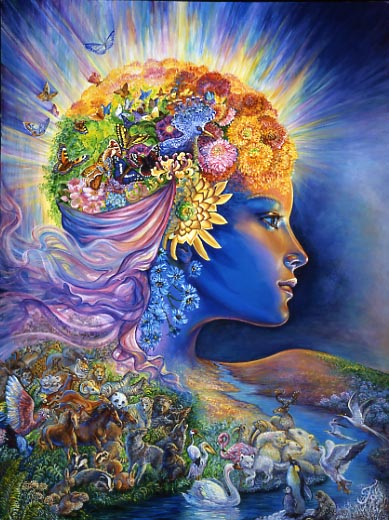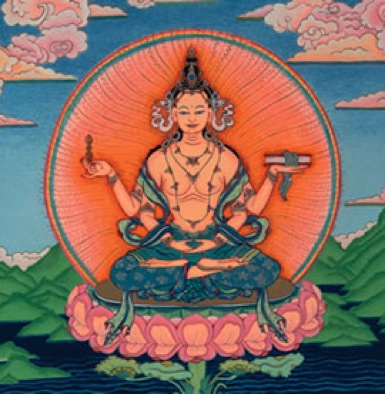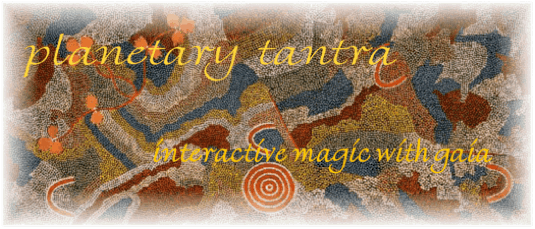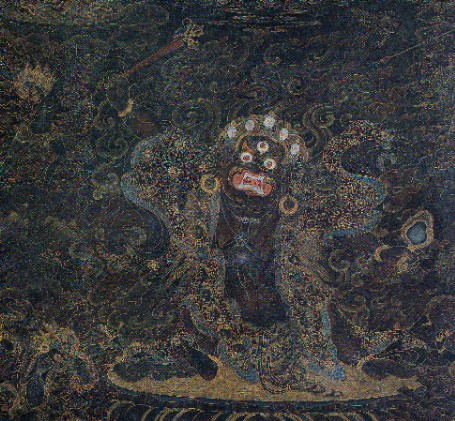| Site Guide |
| Tantra Tour |
| Gaian Tantra Vow |
| Foundations |
| SHAKTI CLUSTER | Dakini Calendar |
| Terma | Sierra de Libar |
Dakini Channels
Interactivity with the Shakti Cluster
Readers may wonder why I am using the terms Shakti and Dakini almost interchangeably. Why don't I just call the Shakti Cluster, modified in my version from ten to eighteen components, the Dakini Cluster? Well, call it that if you like. Shakti Cluster and Dakini Cluster are two names for the same entity, but there are reasons for using both terms: mainly because Shakti Cluster has a more expansive connotation. Allow me to develop this matter a little before proceeding with a tour of the Cluster.
Shakti and Sophia
In Not in His Image, I pointed out that Hindu Tantra is explicitly clear on the dual status of the earth goddess, the Gnostic Sophia. Its asserts that she exists simultaneously in two forms: the torrential luminosity of the primary substance body of the Goddess, consisting of Organic Light, and her planetary body, the earth, consisting of the biosphere and the solid planet.
Shakti who is in Herself pure blissful Consciousness is also the Mother of Nature and is Nature itself born in the creative play of her thought.
- Sir John Woodroffe, The Garland of Letters
Shakti-Sophia is both the Mother of Nature (primary substance body of Organic Light) and Nature itself (the sensory planet, Gaia). Shakti is a name for the Divine Feminine manifesting as the matrix of generative forces that produce and sustain the natural world. "The Sanskrit root shak-, “to be powerful,” also occurs in the Shekinah, a Hebrew name for the presence of the female divinity who was textually excised from Judaic religion. It is the root of words such as sacred, sacerdotal, sacrament, and sacrifice. The compounds Gaia-Shakti and Shakti-Sophia can be useful in asserting the clear and consistent parallels between Goddess mysticism in the West and in Asia" (NIHI p 144).
For Tantrikas, there is nothing in the least remote or abstract about the cosmic agency called Shakti. In The Garland of Letters, Woodroffe cites a cogent Tantric line: “All things exist in Her who is of the nature of feeling in a homogeneous mass.” Shakti is the omnipresent sensuous current of emotive manifestation of pure being in sentient form and mind. It is a felt current that arises in the absolute stillness of the static beholding awareness, Shiva. The term Shakti Cluster is valuable because it brings attention to the fact that the felt current that sustains the material universe, though omnipresent, can and does assume a specific and discrete configuration. This image recalls the "bands of emanations" in the scorcer's explanation presented by don Juan to Castaneda.
The cosmology of Hindu Tantra tallies beautifully with Levantine Gnosis, but Tantric teachings add an additional point, explaining how Shakti-Sophia could turn into the earth and still remain what she is in cosmic terms. “When moved to create, the Great Power or Megale Dynamis of the Gnostics issues from the depths of Being and becomes Mind and Matter whilst remaining what She ever was" (Ibid.). This statement epitomizes the Sophia mythos and confirms that Shakti-Sophia, the Divine Feminine, is not something remote and elevated beyond this world, but is the luminous divinity immanent in the natural world. In Gnostic myth, the Aeon Sophia turns into the earth, morphing into the physical elements of the solid planet, secreting the solid, fluid, and aerial elements of the atmosphere from her own substance, Organic Light. “This primal Power (Adya-Shakti), as object of worship, is the Great Mother (Magna Mater) of all natural things (Natura Naturans) and is Nature itself (Natura Naturata)" (Woodroffe, Shakti and Shakta).

Presence of Gaia by Josephine Wall
So, the value of Shakti is its cosmological scope, combined with the assertion of sensous, material presence. Dakini, when applied to the Shakti Cluster, refers to an elegant differentiation or faceting of the Divine Feminine in its Gaian or planetary modality. The eighteen Dakinis of the Cluster are facets of the Shakti who is Sophia in her cosmic, supra-planetary status, and the living presence of the self-aware planet, Gaia awakening.
The Cluster is actually an eruption of currents in the atmosphere of the earth—such is my observation, based on experimentation with psychoactive plants. The Dakinis are animated images that run on these currents and allow us to identify them and respond to them. Vajravahari is the "face" or facet of one current, Shodashi is the "face" or facet of another, and so on. Each current has a particular frequency or signature, matrika ("letter, code-name") in Sanskrit. By character and intention, theme and style, each of these Dakinis defines a specific vein of Gaian expression, including mental and emotional animation.
To be interactive with the Gaian Dakinis, initially, is to receive and express their characteristic mental and emotional emanations: to get on their wavelengths.
The Whole Shebang
In the current writings, I am approaching the Shakti Cluster from different angles to keep the view fluid and open-ended. In this essay, I want to describe the structure of the Cluster and enumerate the components, the full crew of Dakinis. Having determined that the ten Mahavidyas were the core of a more complex configuration, I arrived at a total of eighteen Dakinis, the whole shebang, arranged like this:
10 Mahavidyas, Hindu Goddesses
5 Tibetan deities classed as Female Buddhas and Wisdom Dakinis
1 Dangerous Guardian from Tibetan Tantra
1 Female Buddha from Mahayana Buddhism
1 Secret Dakini
The ten Mahavidyas have already been named. Here they are again, with some additional characterizations:
1 Kali AKA Mahakali, Kali Ma, the head of the group
2 Tara who delivers us into the realm of liberation
3 Shodashi AKA Sundari, "beautiful one"
4 Bhuvaneshvari goddess of terrestrial forms (bhu = earth)
5 Chinnamasta the self-beheading goddess
6 Bhairavi "terrible one," who annihilates our sense of time
7 Dhumavati "the widow," who reverses misfortunes
8 Bagala AKA Bhagalamuki, "crane-headed" goddess
9 Matangi "the outcaste," mistress of animal powers
10 Kamala goddess of love and desire, who beautifies us
With each encounter with the Mahavidyas, we pick up more detail on their individual traits and powers. Each has her own mantra (sound formula) and yantra (geometrical design). It takes some time to get to know them, but not so long. As you do get to know them, you may find that you are attracted to a certain one more than others. You feel affinities here and there, catch a sharp resonance. You identify. The Mahavidyas have a way of attaching themselves to the psyche of those who will become their devotees. They wil adhere selectively to your imagination of them.

Bhuvaneshvari, pictured with her yantra,
the geometrical design that carries her resonance.
Additional to the core ten Hindu goddesses is a sub-set of five goddesses in the class of Tibetan Wisdom Dakinis (WD) and Female Buddhas (FB). These are:
11 Nairatmya (nai RAHT MYAH), "whose body is the sky" FB
12 Vajravarahi "Diamond Sow,"a powerful revealer WD
13 Kurukulla mistress of witchcraft and enchantment WD
14 Parnashavari "The Leaf-Clad Lady," shamanic deity FB
15 Visvamata "The Variegated Mother," FB
Female Buddhas by Greg Mullin was most helpful in allowing me to pull together these entities, who had been floating around rather randomly in my imagination for a good many years. His vivid descriptions assisted me in placing them in the expanded Cluster, relative to the Tantric Zodiac.
These five dakinis form a distinct group that may be correlated to certain items in Buddhism, particularly the five skandas and the five elements (earth, air, fire, water and akasha or ether), but I am wary of such correlations, as I have already noted. They run quickly into contrivance and distract from the fluid, anomalous nature of these dakinis. These are not gals you can pin down and label, or would want to... I do find, however, that this "mystic pentagram" of two Dakinis and three Female Buddhas is highly suggestive in certain ways, and calls for further investigation in heightened awareness.
After this close-knit unit of five dakinis comes a special pair, a Dangerous Protector and a unique female Female Buddha:
16 Prajnaparamita, the supreme Wisdom Goddess of Mahayana
17 Dutro Lhamo, patron and protector of tertons
Dangerous Protectors belong to a class of Tibetan deities whose role is defence and protection, traditionally considered. What is there to defend and protect, dare I ask? The truth or someone's cherished version of it. We'll see about that. In the fairy-tale account of the introduction of Buddhism into Tibet, Padma Sambhava converted the local demons to protectors of the new message of Buddhism. Who buys this charming story-line? I, for one, do not. I am deeply interested in the nature and activity of Dangerous Protectors, but not along the lines of traditional assumptions. The inclusion of Durtro Lhamo in the Dakini Cluster is somewhat baffling, perhaps. Yet one thing I could say may be helpful: tertons matter to Gaia, so their protection may not be out of place among the activities of the Cluster.
Tertons are shamans who discover hidden treasures of various kinds, but mainly treasure of knowledge and ritual practice. IN a broad sense, termas include revelations, or courses of sacrecd instruction, that come to individuals through attunement to the mind of Gaia, and alignment with her purposes. Traditionally, termas include philosophical teachings on the nature of emptiness, but more often they concern ritual actions such as divination, casting spells, and magical aggression, including the intent to kill. I suspect that Durtro Lhamo's inclusion in the Cluster may have something to do with "contra-violence" and rite action—that is, the use of ritual action against perpetrators, liars, and manipulators who cannot be deterred or defeated by ordinary means.
Dutro Lhamo. Black Thangka (detail), Tibet 18th C.
Demonic Divine, Rubin Museum of Art, New York
Oddly paired with Durtro Lhamo is Prajnaparamita, the "Supreme Insight" Buddha, a female representation of enlightened mind in Mahayana Buddhism. This term is usually translated "Perfection of Wisdom." Traditionally, this figure represents the epitome of Buddhist teachings. Miranda Shaw calls her "the luminous mother of perfect wisdom" and, guess what, "the Buddhist Sophia." Hers is "the serene, clear-sighted gaze of non-dual wisdom." It would be hard to think of any image in all of Buddhist art that summarises the sublime teachings of Buddhism better than this figure.
Scholars have a problem with Prajnaparamita, however. She appears to have emerged suddenly and without apparent origin in Mahayana religion. Experts such as Edward Conze regarded her as "an 'irruption' into Buddhism of Paleolithic and Dravidian mother goddesses." Shaw wonders how to explain "the sudden transformation of the chthonic, fertile earth mother into the metaphysically sublime mother of wisdom?" (Buddhist Goddesses of India, p 167). How, indeed, explain the image of a female earth deity to represent the male-mind constructions of a paternally defined system that is Mahayana philosophy?
Shaw does not explain "the revolutionary shift in Buddhist consciousness" signaled by the emergence of the Prajnaparamita genre of discourse, but I would guess that the production of the principal texts in this genre between 300 and 500 CE corresponds to the insemination of Buddhism by Gnosticism, during the first centuries of the Gnostic diaspora. Prajnaparamita is indeed the Buddhist Sophia and may be well be the evidence of cross-cultural transposition of Sophia into Mahayana. (The same could be said of the Bodhisatta ideal that arose in around 150 CE: it is a transposition of the Gnostic phoster or revealer into Mahayana Buddhism.) Shaw says that this female Buddha, often pictured with a book, is "the ultimate teacher, the instructor of those who seek liberating insight." As such, she would clearly reflect the human presence of the Gnostic teletai who were the educators of the ancient world, although they did not exclusively teach liberation.
There is apparently a trick with Prajnaparamita's role in the Shakti Cluster. She appears to be the front woman or stand-in for another dakini lurking in the background. This other, half-hidden dakini is called—bear with me, folks—Suryacandrasiddhi, "accomplished like the powers of the sun and moon." Her Tibetan name is Pema Kethang. She is also called Guhyajnana, "Secret Wisdom," and Lekyi Wangmo, "Powerful Lady." This dakini is extremely famous in Tibetan lore, because she is known to have been the first initiator of Padma Sambhava, the founder of Vajrayana.
I am in the process of learning more about the peculiar arrangement of channel 17. So far, I understand that the Secret Wisdom Dakini grants special instruction to those who come to her initially through Prajnaparamita. In other words, Prajnaparamita is a source of general teachings about compassion, consistent with the traditional doctrines in Mahayana Buddhism, but the Secret Wisdom Dakini represents a deeper, and perhaps darker, view of enlightenment about compassion. This less-known perspective may include what scholars call "transgressive views"— that is, views that go against the norm and defy ordinary ethical assumptions. In this respect, the Secret Wisdom Dakini would be well matched with the Dangerous Protector, Durtro Lhamo, whose protective powers include magical agression and other ethically dubious powers.
I do not list Prajnaparamita and the Suryacandrasiddhi as two dakinis, 17 and 18, because they appear to function as one channel with two interchangeable frequencies. More at eleven, folks.

Prajnaparamita, the Perfection of Wisdom
Channel l8
Finally, we come to the last dakini in the expanded Shakti Cluster:
18 The Secret or Unnamed Dakini
The Gaian Dakinis, in general, represent the supernatural source of a subliminal mind activity grounded in the planetary matrix. Their "frequencies" are the streamings of Gaian intelligence into the human realm, but in a particular way, with a particular intent. The Dakinis of the Shakti Cluster are broadcast channels in the mind of Gaia. There are certainly countless such channels, for the mind of Gaia is the living intelligence of nature that speaks to humanity in a myriad ways. For instance, ayahausca shamans of Peru recognize a host of spirits who animate the forest and speak to them, either through animals and plants or by visionary entities including great luminous snakes such Sachamama. The Green Man of European folklore is another example of a forest spirit who represents the Gaian mind communicating with humanity.
The Dakinis of the Shakti Cluster present a totally unique expression of Gaian intelligence, distinct from other local and tellurian expressions. This “console” of eighteen channels is dedicated to a single and specific purpose. The Dakini channels are planetary in scope, not restricted to a particular locale or ecosystem. Their broadcast range is truly global, for these are the channels through which Gaia recognizes and directs her lucid dream. Planetary Tantra is precisely that: it concerns the global, planet-wide ramifications of Gaia's lucid dream and our participation in it.
Consider this analogy: a solitary woman, a well-known “performing artist,” is engaged in a performance in a large theater. The theater is empty, with no one attending, but eighteen cameras are placed around it to film the performance. Now imagine that you are in a room away from the theater, looking at eighteen monitors that show the performance of the woman artist from different angles and distances, far and near. Scanning the eighteen monitors, you get an overall view of the performance taking place in the empty theater. You are not there in the theater with the performance artist, but you can see what she's doing.
Imagine also that there is a camera on you, just one camera. The monitor for this camera is in the theater where the woman artist is performing. With that monitor, she can observe you as you witness her performance, and even communicate with you, talking to the screen, for the camera on you has a microphone attached, of course. The set-up of eighteen cameras for the artist and one for yourself enables communication and interactivity between the artist and you. You could, for instance, comment on the performance or suggest things to do, modifications of her actions. The performing artist could respond accordingly, or she could tell you things to do that would involve you in her performance, or enable you to follow what she was doing and thinking with a clear and current understanding of her every act and expression.
Now imagine that all the eighteen cameras in the empty theater, except one, are fixed. There is one moving camera, as used in CTTV to monitor public places. This camera is always on the face of the performing artist. It follows her expression and records her words, continuously. Likewise, the single camera on you is on your face, giving the artist direct access to your face and voice on the monitor in the theater where she is performing. One camera of the eighteen on her face, one camera on yours, with the corresponding monitors: this is the optimal set-up for two-way communication and interaction.
Here the analogy comes back to the Unnamed Dakini. The camera on the face of the performing artist is channel 18: the Dakini who presents the attention of Gaia to human access. The camera on your face is Gaia’s channel of direct access to your attention, the complementary view. The monitor that shows your face to the performing artist is on "direct feed" to Gaia. You see channel 18 on the 18th monitor, but attached to that monitor is the camera that feeds your voice and image directly to Gaia. Channel 18 is the two-way access between a human witness to Gaia's lucid dream and Gaia as she recognizes herself in the dream, awakening within it, and acting out the dream.
According to my instruction, direct access to the attention of Gaia will be opened globally on January 26, 2009. It opens with the disclosure of the name of Dakini 18. Anyone who invokes Gaia by that secret name will be able to activate that unique channel and become interactive in Gaia's lucid dream. Gaia may be called by many names: Prthivi, Sthavara, Demeter, the Great Mother, and more, but the loveliest question is, What name will she answer to?
To get her attention it is necessary to call Gaia by the name she will answer to, the name she calls herself, her identity in the lucid dream.
The name of Dakini 18 is the name Gaia will answer to. This is the name to invoke to get her attention connected to your attention. I will release that name on this site on midnight January 26, 2009.
jll: 28 November 2008 Andalucia


